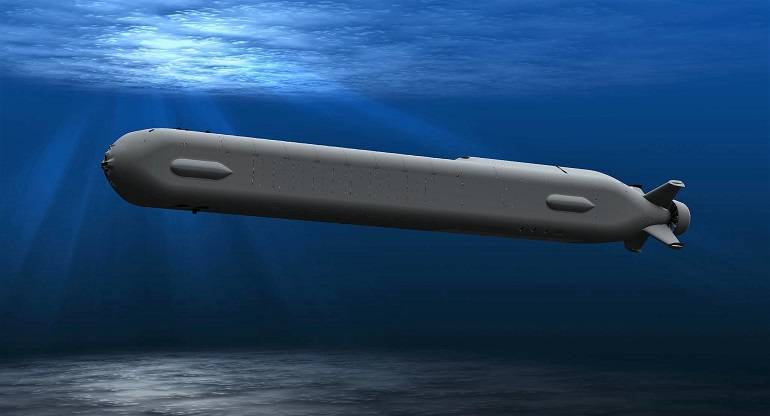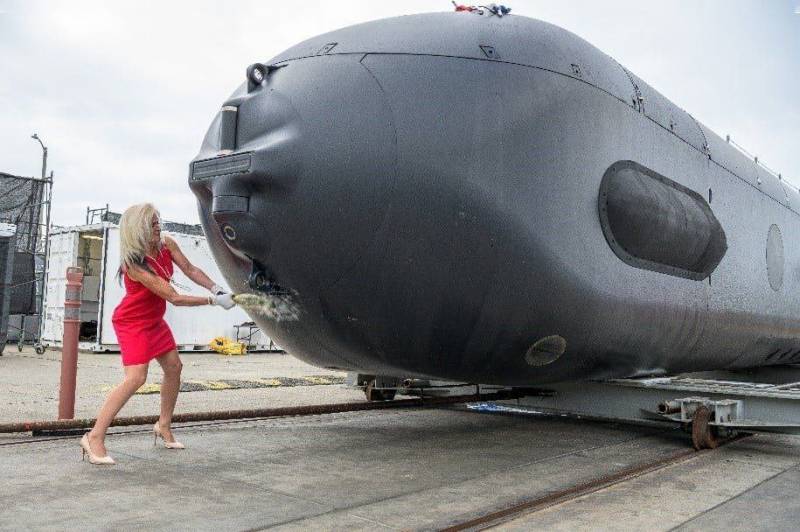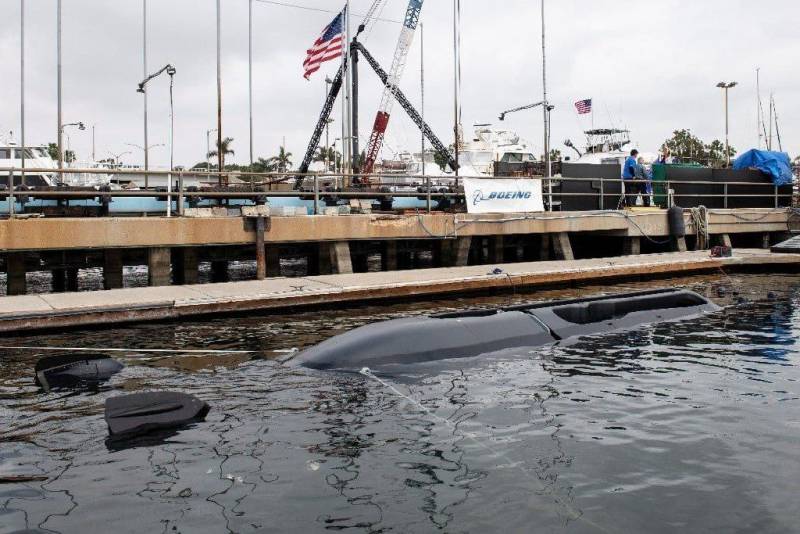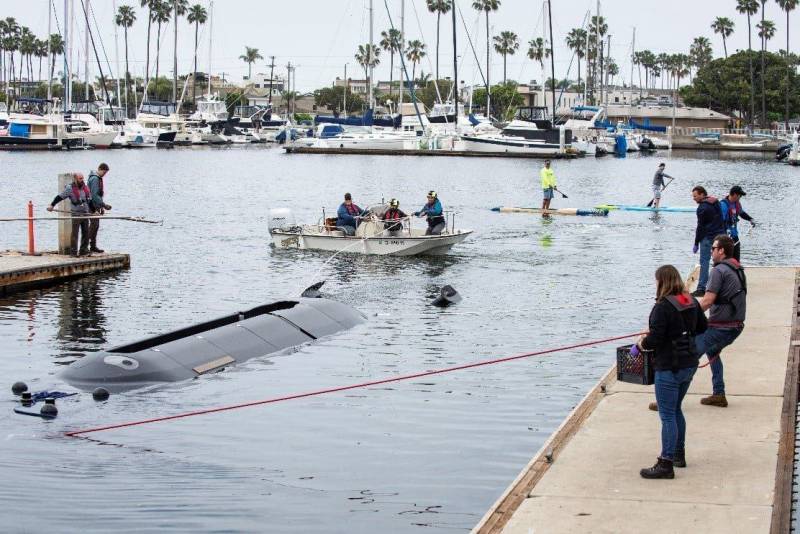Boeing / HII Orca XLUUV submersible enters trials
Boeing, in collaboration with Huntington Ingalls Industries, has completed the construction of the first experimental autonomous unmanned underwater vehicle (AUV) Orca XLUUV. It was recently launched, and now sea trials should begin. In the near future, it is expected to complete the construction of several further devices of this type, which will be involved in full-scale tests.
First prototype
On May 6, the US Naval Systems Command (NAVSEA) announced the completion of the construction of the first experimental AUV and the imminent start of its testing. On April 28, at Boeing's new site in Huntington Beach, Calif., the first Orca XLUUV was officially christened and launched.
In the presence of representatives of the Pentagon and the Navy, incl. responsible for the unmanned sea direction, a new AUV broke a bottle of champagne. Then the device was lowered into the water, moored to the pier, and preparations began for future sea trials.
Various statements were made during the ceremony. The new Orca XLUUV project was generally highly acclaimed. In addition, they noted the great importance of the first prototype. In the near future, he was supposed to go on sea trials, although the timing of this was not specified. Then it will be followed by several new prototypes, which will also be involved in test and research activities.
It is very likely that the first experimental AUV has already begun testing, but NAVSEA has not yet announced this. The timing of the appearance of the following samples is also not specified. According to the terms of the contract, they must be transferred before the end of the year. Whether it will be possible to meet such a schedule, time will tell.
Perspective development
The Orca XLUUV (Extra-Large Unmanned Undersea Vehicle) project goes back to an earlier Boeing AUV called the Echo Voyager. The latter was developed on its own initiative and presented in 2016. Since 2017, such a device has undergone various tests, the results of which then became of interest to the US Navy.
The development of the Orca product in its current form began at the end of 2017 and was carried out as part of the NAVSEA program called XLUUV. In early 2019, this project was recognized as the most successful, and Boeing and HII received a contract to continue its development. They received $43 million to complete the technical design, as well as $275 million to build five prototypes. Under the terms of the contract, all prototypes must be submitted for testing by the end of 2022.
The construction of experienced Orca XLUUV is carried out by both development companies. Shipbuilders from HII assemble the hull structures, which are then transferred to the Boeing Phantom Works site in Huntington Beach. All necessary systems, units and devices are installed there.
The first of the ordered prototypes is already ready and launched. The remaining four are in various stages of production, but no technical details are available. According to the terms of the contract, a little more than six months are left to complete the work.
Multipurpose platform
The Orca XLUUV project provides for the creation of a large "super-heavy" underwater platform capable of carrying various payloads. With the help of AUVs with one or another equipment, it is proposed to carry out patrols, conduct reconnaissance, conduct electronic warfare, etc. In the long term, the introduction of weapons is not ruled out.
The Orca XLUUV is a 26 m long uninhabited submarine. It is built in a high elongation hull with straightened sides. There is a notch on top of the hull, probably for the payload module. In the stern there are X-shaped rudders and an annular channel of the propeller or a water cannon.
The AUV is equipped with a diesel-electric power plant with full electric propulsion. It includes a diesel generator of unnamed type and capacity, as well as high-capacity lithium-ion batteries and a propeller motor. A power reserve of 18 kW is provided to power the payload.
The maximum design speed of the Orca XLUUV under water reaches 8 knots. Economic - 3 knots, which will give a cruising range of up to 6500 miles and autonomy of several months. The device will perform tasks in a submerged position using batteries. If necessary, it will float up and turn on diesel generators for recharging - like a full-size manned diesel-electric submarine.
The apparatus-platform is equipped with its own hydroacoustic means, means of navigation and communication. Using the developments of the Echo Voyager project, new control systems have been created. They are able to control navigation and monitor general ship systems, control the payload, exchange data with the operator, etc.
The Orca hull has a payload bay 10 m long; it can accommodate equipment with a total weight of up to 8 tons. The payload will be modular and interchangeable. At the first stage, it is planned to introduce modules with various sensors and other similar equipment. Then work will begin on new reconnaissance equipment, electronic warfare systems, etc.
With the confirmation of the calculated capabilities, it is possible to introduce weapons. The dimensions of the compartment in theory make it possible to transport and use small-sized anti-submarine torpedoes of existing types. Will new weapon specifically for the AUV, is unknown.
Test plan
In the near future, the first experimental AUV Orca XLUUV must pass sea trials and confirm the characteristics of power and general ship systems. In the future, the remaining four samples will pass the same test. If there are no problems with the main units, the products will be admitted to the next tests.

With the help of several experimental devices, NAVSEA plans to form and work out the general concepts for the use of such equipment. Questions of independent and group work, performance of various tasks, etc. will be studied. In parallel, work will begin on the payload. First of all, it is supposed to install and test sonar systems and anti-mine equipment. Then, as the work continues, new devices and assemblies will be brought out for testing, up to weapons.
The result of testing, research and development will be a full-fledged multifunctional autonomous underwater complex, as well as methods for its application to solve various problems. If such a complex meets the requirements of the customer, it will be put into series and begin to be mastered in parts of the Navy. Otherwise, Orca XLUUV may become the basis for a new, more advanced AUV.
Distant future
The Orca XLUUV project is part of a full-scale program to develop advanced autonomous underwater systems for the US Navy. In parallel with the “super-heavy” autonomous vehicle from Boeing and HII, several other projects are being developed in other weight and size categories with different capabilities.
In the future, the Pentagon plans to create fleet unmanned submarine forces equipped with equipment of various classes and types. New AUVs will be able to patrol and solve other tasks both near the coast and in the ocean zone. They will complement the "traditional" ships and submarines of the fleet and take on some of their work. It is expected that due to this it will be possible to increase the overall capabilities of the Navy with certain savings on the construction of equipment.
To date, several promising AUVs of various classes and types have been brought to testing at once. In the coming years, they can reach full operation. In particular, the heavy Orca XLUUV may enter service in the second half of the decade. However, before this it is necessary to carry out a lot of activities and tests. They are just beginning, and their ending is still unknown.




Information